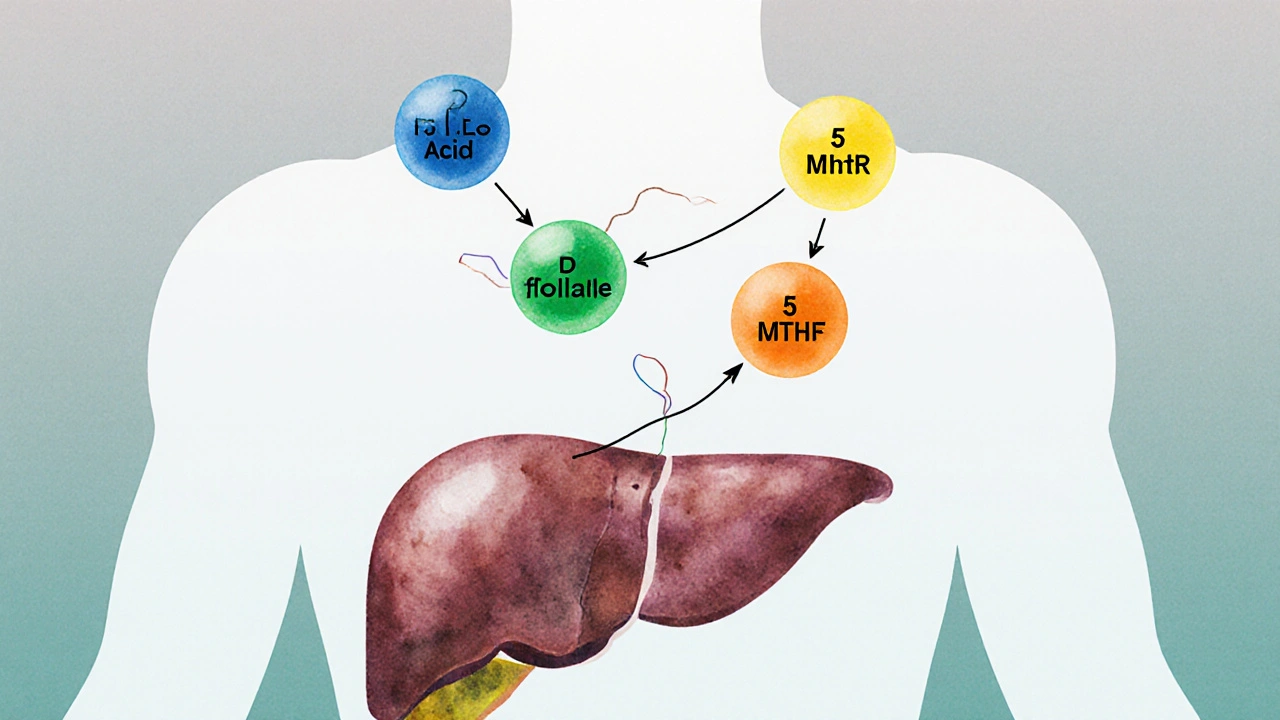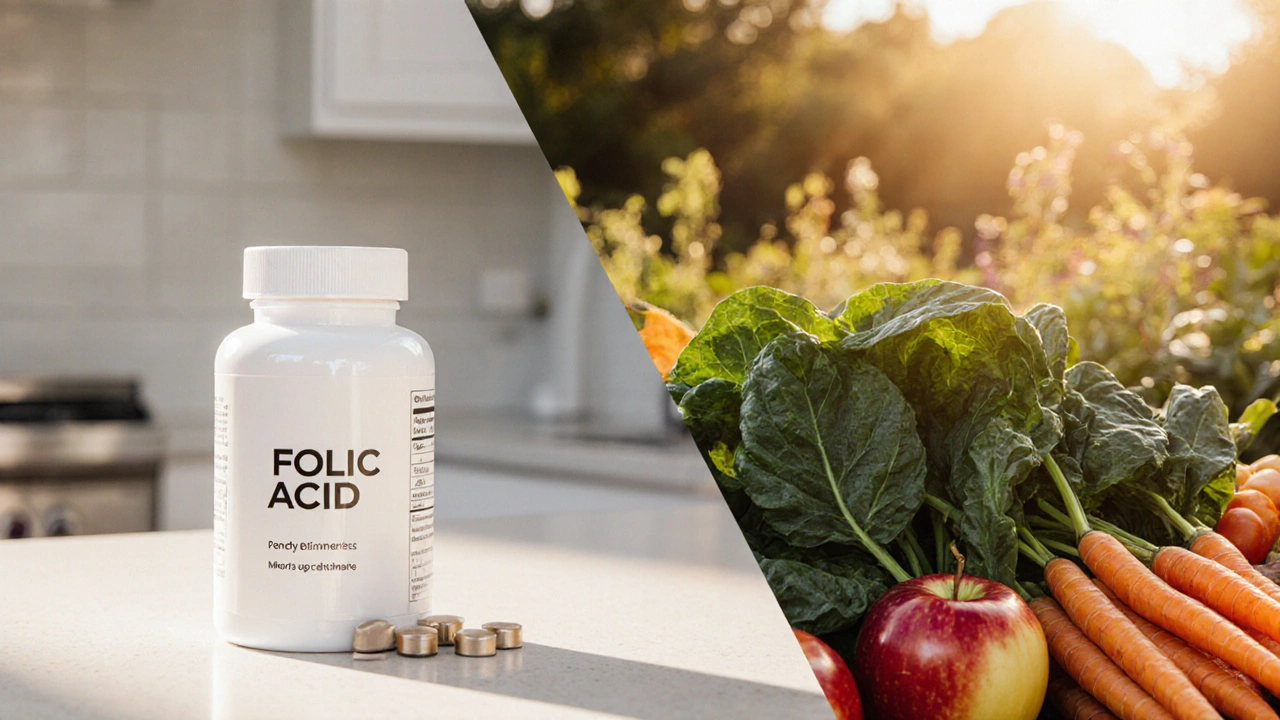B9 Supplement Decision Tool
Answer these questions based on your personal health situation to find the best B9 supplement for you. The tool considers your health goals, genetic factors, medications, diet, and budget.
When it comes to boosting vitamin B9 levels, most people reach for a bottle of folic acid alternatives without knowing how the options differ. Below we break down the chemistry, absorption, typical uses, and safety notes for the most common B9 supplements so you can pick the one that truly fits your health goals.
What Exactly Is Folic Acid?
Folic Acid is a synthetic form of vitamin B9 that was first isolated in the 1940s. It is stable, inexpensive, and widely used in fortified foods and over‑the‑counter tablets. Because it’s not found naturally in foods, the body must convert it into the active form 5‑methyltetrahydrofolate (5‑MTHF) before it can participate in DNA synthesis, red blood cell formation, and homocysteine metabolism.
Top Alternatives to Folic Acid
Three alternatives dominate the market today:
- Methylfolate, also called 5‑MTHF, is the bio‑active form that the body can use directly.
- Folinic Acid (leucovorin) sits one step ahead of folic acid in the conversion pathway, bypassing a key enzymatic step.
- Dietary Folate refers to the naturally occurring B9 found in leafy greens, legumes, and citrus fruits.
All three are often marketed as “folate supplements,” but they behave very differently once inside your bloodstream.
How the Body Processes Each Form
Understanding the metabolic steps helps explain why some people feel better on one form versus another.
- Folic Acid: After ingestion, the liver’s enzyme dihydrofolate reductase (DHFR) reduces folic acid to dihydrofolate, then to tetrahydrofolate, and finally to 5‑MTHF. DHFR activity varies widely among individuals, especially those with certain genetic variants (e.g., MTHFR C677T). Low DHFR activity can leave unmetabolized folic acid circulating, which some studies link to altered immune function.
- Methylfolate: Delivered as 5‑MTHF, it skips the DHFR step entirely. The molecule is ready for methylation reactions that regulate homocysteine, neurotransmitter synthesis, and gene expression. Bioavailability studies show 70‑85% absorption compared to roughly 50% for folic acid.
- Folinic Acid: Converted directly to tetrahydrofolate, it still requires one enzymatic step before becoming 5‑MTHF. This makes it useful in chemotherapy rescue protocols where rapid folate replenishment is needed, yet it remains slightly less ready than methylfolate.

Comparison Table: Key Attributes
| Attribute | Folic Acid | Methylfolate (5‑MTHF) | Folinic Acid (Leucovorin) | Dietary Folate |
|---|---|---|---|---|
| Chemical Form | Synthetic p‑aminobenzoyl‑glutamate | 5‑Methyltetrahydrofolate | 5‑Formyltetrahydrofolate | Polyglutamylated folates (e.g., 5‑MTHF, 10‑formyl‑THF) |
| Bioavailability* | ~50% | 70‑85% | ~65% | Varies 30‑70% depending on food matrix |
| Typical Dose (adult) | 400‑800µg (as synthetic) | 400‑1000µg (as 5‑MTHF) | 400‑800µg (as leucovorin) | 300‑600µg from diet |
| Primary Uses | Pregnancy prevention of neural‑tube defects, general B9 deficiency | Pregnancy, mood support, cardiovascular health, MTHFR‑related issues | Chemotherapy rescue, certain anemia types | Whole‑food nutrition, chronic disease prevention |
| Pros | Cheap, widely available, stable in fortified foods | Directly usable, fewer unmetabolized residues, better for MTHFR carriers | Effective in medical protocols, less likely to cause excess homocysteine | Provides additional nutrients, no synthetic additives |
| Cons | Requires DHFR conversion, may accumulate unmetabolized folic acid | More expensive, sometimes limited in strength | Not as common in OTC supplements, slightly higher cost | Variable intake, cooking can degrade folate content |
*Bioavailability figures are averages from peer‑reviewed nutrition journals published between 2018‑2024.
Who Might Prefer Each Option?
Pregnant women or those planning pregnancy usually get the green light for 400µg of folic acid daily, as mandated by most health agencies. However, if you carry the MTHFR C677T mutation, methylfolate can provide a more reliable boost without relying on DHFR.
People on antidepressants or dealing with mood swings often report better outcomes with methylfolate because it supports neurotransmitter synthesis directly.
Cancer patients undergoing methotrexate therapy are prescribed folinic acid (leucovorin) to “rescue” healthy cells, making this form essential in that clinical context.
Those who prioritize whole‑food nutrition may choose to meet their B9 needs through leafy greens, beans, and citrus. This approach also delivers fiber, potassium, and other phytonutrients.
Safety, Interactions, and Upper Limits
All B9 forms share a common safety profile but differ in interaction risk.
- Folic Acid: Generally safe up to 1mg/day for adults. Very high doses (>5mg) can mask vitamin B12 deficiency symptoms, leading to neurological damage.
- Methylfolate: Similar upper limit, but because it bypasses conversion steps, it may raise serum folate more quickly. Caution with antiepileptic drugs that alter folate metabolism.
- Folinic Acid: Used therapeutically in higher doses (up to 10mg/day) under medical supervision. Interaction with anti‑folate chemotherapy agents is expected and purposeful.
- Dietary Folate: No known toxicity; excess intake simply excreted in urine.
People on anti‑coagulants (e.g., warfarin) should monitor INR levels when changing folate intake, as folate can influence homocysteine‑related clotting pathways.

Cost and Availability Considerations
Price can be a deciding factor. In the UK market, a 100‑tablet pack of 400µg folic acid costs roughly £2, while a comparable pack of methylfolate runs £8‑£12. Folinic acid is typically sold in specialty pharmacies for around £15 per 30‑tablet pack, reflecting its clinical niche.
For budget‑conscious consumers, a mixed strategy-using folic acid for basic coverage and adding a weekly methylfolate supplement for specific needs-can balance cost and efficacy.
Practical Guidance: Choosing the Right B9 Supplement
- Assess your health goals. Pregnancy? Mood support? Chemotherapy?
- Check genetics. If you’ve been tested for MTHFR variants, lean toward methylfolate.
- Review current medications. Anticonvulsants, anticoagulants, or methotrexate may dictate a specific form.
- Consider diet. If you already eat a folate‑rich diet, a low‑dose supplement may suffice.
- Set a budget. Factor in the per‑dose cost and frequency of purchase.
- Start low, monitor. Begin with the recommended daily amount, track any side effects, and adjust under medical advice.
Remember, supplementation is just one piece of the puzzle. Adequate protein, B‑vitamin complex, and a balanced lifestyle amplify the benefits of any folate source.
Frequently Asked Questions
Can I take methylfolate and folic acid together?
Yes, many clinicians recommend a combined approach for people with borderline deficiency. The methylfolate handles the active pathway, while folic acid adds a safety net. However, keep total B9 intake under the 1mg daily upper limit unless advised otherwise by a healthcare professional.
Is dietary folate enough for pregnancy?
Whole‑food sources are excellent, but studies show that supplementing with 400µg of folic acid (or equivalent methylfolate) reduces neural‑tube defect risk by up to 70%. Most health agencies still recommend a supplement during the first trimester.
What is the difference between folinic acid and leucovorin?
They are the same compound. "Leucovorin" is the trade name, while "folinic acid" describes the chemical structure (5‑formyl‑THF). Both skip the DHFR step and are used medically to rescue normal cells from anti‑folate drugs.
Can excess folic acid hide a B12 deficiency?
Yes. High folic acid can correct the anemia caused by B12 deficiency without fixing nerve damage, delaying diagnosis. If you’re over 50 or have neurological symptoms, test both B12 and folate levels.
Which B9 form is best for someone with the MTHFR C677T mutation?
Methylfolate (5‑MTHF) is preferred because it bypasses the reduced‑function MTHFR enzyme, delivering the active form straight to the cells.
